Gumbo Vs Jambalaya: What's The Difference?
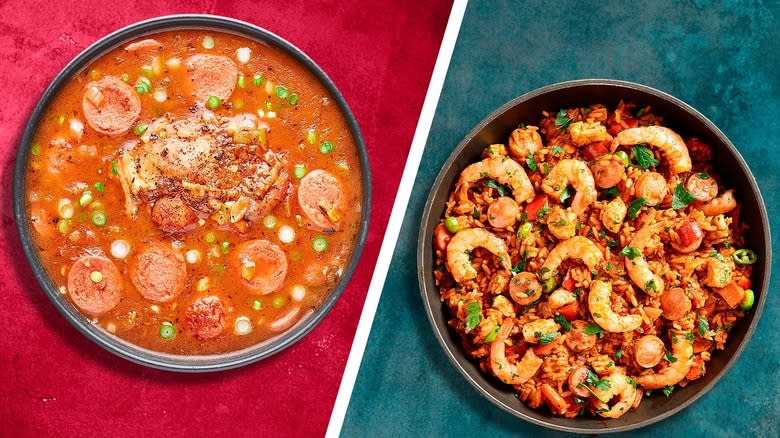
Most anyone who's lived in or visited the southeastern part of the United States has experienced Cajun and Creole cuisine in one way or another. That's especially true in Louisiana communities where those specific cuisines evolved over many years of influence, ranging from ancient culinary arts to newcomer perspectives and exotic fusions along the way. Both metropolitan and country-style customs determine how Cajun-Creole dishes vary, including what's arguably the top two: gumbo and jambalaya.
Even the colorful Louisiana names speak their own foodie languages, with "gumbo" deriving from the West African word "ki ngombo," meaning okra, a primary ingredient in many versions of gumbo. Jambalaya breaks down by syllables into Creole words with reported influence ranging from French, Spanish, Acadian, or African roots: "jamb" meaning ham and "ya" being an African word for rice. There was apparently even a Provencal word "jambalaia" referring to a similar rice-based dish.
In other words, both gumbo and jambalaya carry layers of history spanning the globe and that's not even counting some obvious influence from Native American foods long before the arrival of outsiders. Although the intricacies of Cajun and Creole cuisines are many, they constantly intersect and influence one another, particularly when it comes to the gumbo and jambalaya interpretations on countless dining-room tables, restaurant menus, street food carts, and lively cultural celebrations. Here's a look at the difference between these two culinary heavy-hitters from Louisiana.
Read more: 21 Delicious Ways To Use Up Leftover Rice
What Is Gumbo?
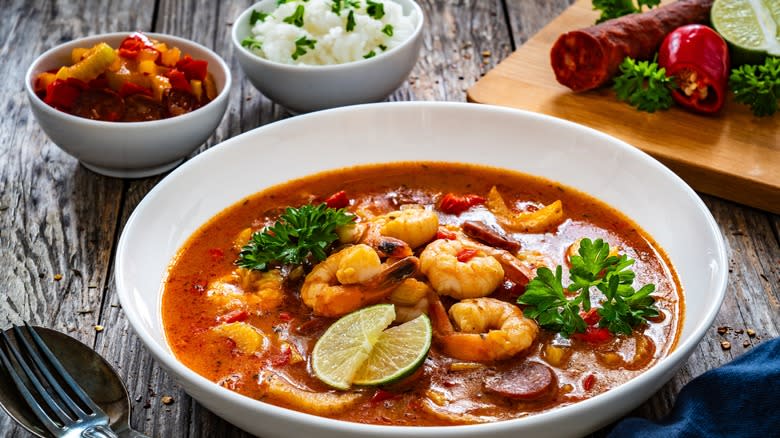
Once you've actually tasted gumbo, regardless of which version you're lucky enough to experience, you'll never again wonder about this curiously named dish. It's one of those foods that leave an indelible impression, almost as though it had a life of its own. It certainly brings stories to the table, digging deep into America's history, from French and European settlers to the West African slave trade and existing Native American foodways.
When all is said and done, what we know today as gumbo is a thick, hearty stew filled with seafood or meat, generally shrimp or chicken; a lot of vegetables, specifically okra; and a lively parade of aromatic spices. The essence of what's really in a gumbo comes down to whether it emerges from a Creole or Cajun chef. Both communities proudly produce intricately nuanced gumbo versions while they share the essentials, including the infamous holy trinity of finely diced celery, onions, and bell peppers. Creole gumbo also incorporates tomatoes as well as filé powder, an ingredient deriving from the Choctaw practice of drying and grinding sassafras leaves.
Both gumbos start with a roux, which is a carefully cultivated thickener comprised of flour and a fat such as vegetable oil or bacon drippings. Either version can include shellfish, typically shrimp, and aromatic herbs and spices such as bay leaves, thyme parsley, cayenne pepper, oregano, and various regional spice mixtures. Cajun gumbo very likely includes andouille sausage, chicken, and often shrimp or crab.
What Is Jambalaya?
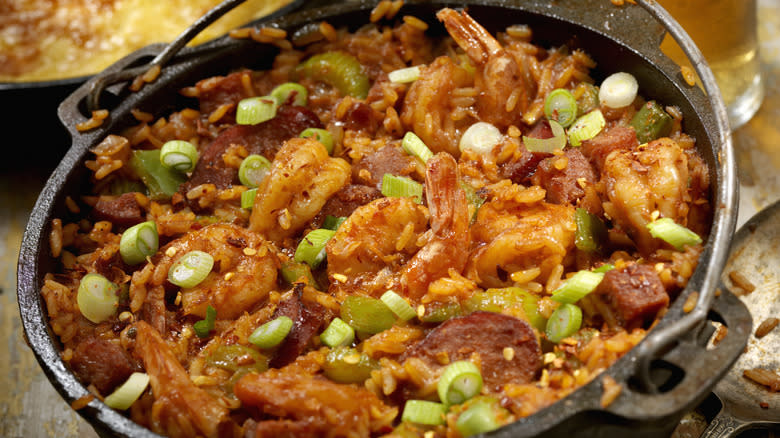
Jambalaya carries a singsong name that's fitting for the glorious sway of ingredients making up this rice-based dish. Like gumbo, cultural influences on jambalaya are diverse, intense, and impactful. But unlike gumbo, there aren't quite as many variations between Cajun and Creole interpretations of this now-classic Southern favorite. The variations that do exist often involve tomatoes, with Creole tendencies toward them, resulting in a red jambalaya compared to a brown Cajun one.
As its name etymology suggests, jambalaya often features ham but can easily include a mishmash of proteins like the traditional andouille sausage, poultry, or even gamier meats as seasonally available. It's not unusual to find sausage, chicken, shrimp, crawfish, or poultry quite happily coexisting within the same pan of jambalaya. There will always be the holy trinity of celery, bell peppers, and onions involved, as that's the foundational base for most Cajun and Creole cooking.
As for the other vegetables, spices, and herbs, they're almost identical to ones often used in gumbo, including okra, garlic, red pepper flakes, Cajun seasoning mixes, bay leaves, thyme, and the flavor-defining sassafras filé powder. As a tomato-forward one-pot dish, jambalaya recipes can include anything from fresh diced tomatoes to tomato paste, crushed canned tomatoes, or a combination of all those. Then there's the rice and therein lies the primary difference between gumbo and jambalaya.
Rice Is The Main Distinguisher Between Gumbo And Jambalaya
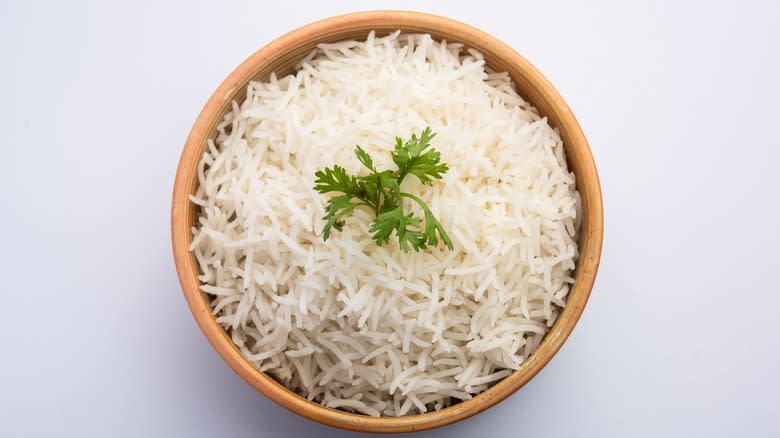
Rice features prominently in both gumbo and jambalaya but in very different ways. In fact, rice is the primary distinguisher between these culinary siblings with almost identical heritages and ingredients. It's not the specific type of rice, although long-grained versions such as Louisiana or basmati are highly preferred for jambalaya to avoid a mushy mess in the pan. That pan, and how it features in building a tasty jambalaya, is where it takes a divergent path from gumbo.
Gumbo, being a stew with varying degrees of thickness based on the chef, is served as a standalone dish with a highly customary accompaniment of rice. Some chefs serve the rice on the side, but many layer the rice in the bottom of a large bowl and pour the gumbo over it. The diner digs deeply into the bowl with a spoon, scooping up portions of rice and gumbo together in each bite.
In contrast, the rice in jambalaya is cooked right into the pan along with all the other ingredients. It's truly a one-pot wonder, merging as a rice-meat-veggie dish similar to a Spanish paella sans the saffron. It's often compared to paella and tied to Spanish ownership of Louisiana in the late 1770s. Spanish settlers reportedly substituted traditional paella ingredients for ones available in their new homeland while retaining the basic structure of rice cooked directly into the dish. This eventually became jambalaya.
About The Roux, Or Lack Thereof
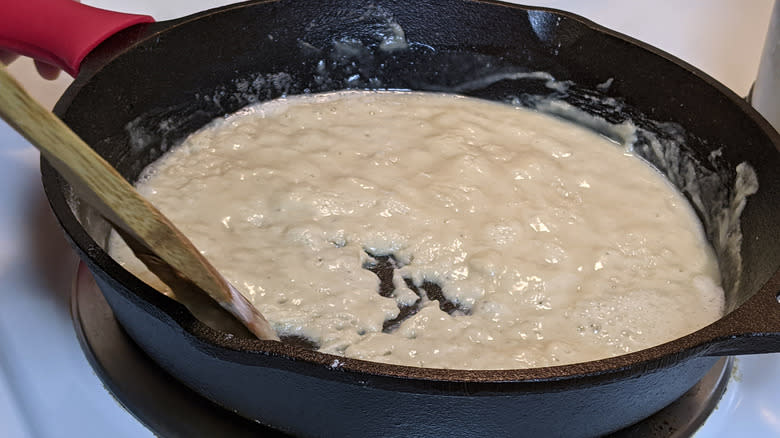
Although rice preparation is the primary difference between gumbo and jambalaya, there's another smaller, yet often overlooked, component missing in a jambalaya recipe. It's that little mound of flour and fat that magically morphs into a roux, causing more than a few controversies between gumbo aficionados.
With jambalaya, there's no debating over how long to cook the roux, how dark to let it become, and how to keep it from scorching and ruining a perfectly planned pot of gumbo. That's because jambalaya bypasses it altogether. A flour-based roux serves as a thickener for stews such as gumbo, but jambalaya does not need that. The rice that's cooking right there in the pan along with its fellow soul mates is all the thickener that's needed. Most jambalaya recipes don't call for flour or any type of thickening agent.
Despite their important distinctions, gumbo and jambalaya have so much shared history and so many identical components. The versions we know today evolved over thousands of years along with the culturally distinct Cajun and Creole communities continuing to dole out spicy goodness from pans, bowls, skillets, and one-pot wonders.
Read the original article on Tasting Table.

